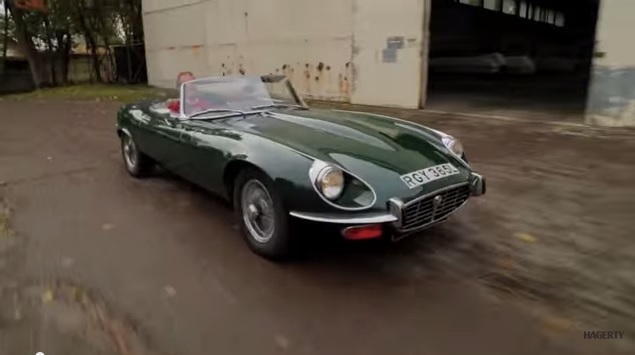-
Insurance
InsuranceAbout our productsLearn about insuringGet a quote Get current values, historical values, model history and more.
-
Valuation
ValuationHagerty valuation toolLook up a vehicle value Get current values, historical values, model history and more.
-
Events
EventsHagerty official eventsHagerty ClubhouseEvent calendar
-
Entertainment
EntertainmentMore to explore
- Portal login
1973 Jaguar E-type
SIII Roadster 5.3 L
Vehicle values by condition
Fair
Condition 4
£33,600
#4 cars are daily drivers, with flaws visible to the naked eye. The chrome might have pitting or scratches, the windshield might be chipped.
Good
Condition 3
£45,400
#3 cars could possess some, but not all of the issues of a #4 car, but they will be balanced by other factors such as a fresh paint job or a new, correct interior.
Excellent
Condition 2
£65,400
#2 cars could win a local or regional show. They can be former #1 cars that have been driven or have aged. Seasoned observers will have to look closely for flaws.
Concours
Condition 1
£93,500
#1 vehicles are the best in the world. The visual image is of the best car, unmodified, in the right colours, driving onto the lawn at the finest concours.
Insurance premium for a
1973 Jaguar E-type SIII Roadster 5343
valued at £45,400
£262.33
/ year*
History of the 1971 - 1975 Jaguar E-type

1971 - 1975 Jaguar E-type
The 5.3-litre aluminium V-12 engine was the first all-new Jaguar engine since the 3.4-litre twin-cam 6-cylinder for the XK120, back in 1948. The Series III E-Type was launched in December 1971, and coupe and roadster were on the longer 105-inch, 2+2 chassis.
The body was modified, losing some of the sleekness of the Series I and II cars. The hood bulge was larger, wheel arches became flared, and the open intake was screened with an egg-crate grille. Buyers could opt for slotted steel or knock-off wire wheels.
The 5.3-litre engine was a 60-degree, single-overhead camshaft V-12, developing 272 bhp. Under the hood were four Zenith carburettors and a single 12-cylinder distributor at the rear of the engine’s vee, where it was subjected to fierce heat. Horsepower started out at 272 bhp, good for 0-60 mph in 6.4 seconds, and a top speed of 146 mph, but it was reduced in the US by emissions restrictions to about 240 bhp by 1974. At this time large rubber bumpers appeared for the American audience due to government regulations.
An automatic transmission was optional, and all V-12 E-Types came with power steering. Air conditioning was also optional and often equipped for export markets. The press loved the quiet V-12 engine, but weren’t thrilled by 15 mpg. They were also were critical of the chassis, which they thought was outdated. The interior was praised for the dashboard, gauges and trim, but there were grumbles about it being cramped.
The general complaint was that the car had become a grand tourer, especially as it now cost £3123 in roadster form. Though journalist and Le Mans winner Paul Frere averaged 128 mph across Europe, most cars were bought by older drivers and not driven hard, often suffering from lack of use. E-Type production was divided evenly as usual, and of the 15,287 Series IIIs built, 7,297 were coupes and 7,990 convertibles. About 80 percent were sold in the US.
Both models were doomed after the 1973 petrol crisis. The E-Type could not meet US safety regulations after 1974, but both the roadster and coupe lasted another year in the UK, with the final 50 roadsters painted black, with a special dash plaque.
All 1973 Jaguar E-type body types
| Year | Make | Model | Submodel | Body Type | Engine size | Average value |
|---|---|---|---|---|---|---|
| 1971 | Jaguar | E-Type | SIII | 2+2 Coupe | 5.3 L | £ 18,500 29,900 40,600 55,300 |
| 1971 | Jaguar | E-Type | SIII | Roadster | 5.3 L | £ 33,600 45,400 65,400 93,500 |
Hagerty Newsletter
Get your weekly dose of car news from Hagerty UK in your inbox

ADVERTISEMENT